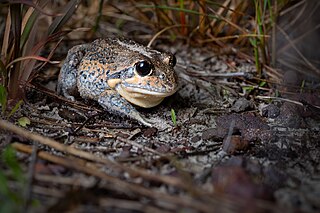
Limnodynastes dumerilii is a frog species from the family Limnodynastidae. The informal names for the species and its subspecies include eastern or southern banjo frog, and bull frog. The frog is also called the pobblebonk after its distinctive "bonk" call, which is likened to a banjo string being plucked. There are five subspecies of L. dumerilii, each with different skin coloration. The species is native to eastern Australia. There has been one occurrence in New Zealand, when tadpoles of the species were found in 1999 and destroyed.

The white-lipped tree frog is a species of frog in the subfamily Pelodryadinae. It is the world's largest tree frog and is found in Australia. Other common names include the New Guinea treefrog, giant tree frog, and Australian giant treefrog.
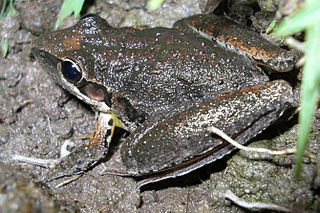
The broad-palmed frog is a species of ground-dwelling tree frog. It is native to much of eastern Australia. They can be found from mid-Queensland to south of Sydney. It is associated with the coast and inland, and is distributed as far west in New South Wales to the South Australia border.

The common eastern froglet is a very common, Australian ground-dwelling frog, of the family Myobatrachidae.

The spotted grass frog or spotted marsh frog is a terrestrial frog native to Australia. It is distributed throughout all of New South Wales and Victoria, eastern South Australia, the majority of Queensland, and eastern Tasmania. It is also naturalised in Western Australia, having been unintentionally introduced at Kununurra in the 1970s, apparently during the relocation of several hundred transportable homes from Adelaide.
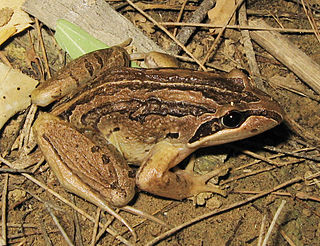
The striped marsh frog or brown-striped frog is a predominantly aquatic frog native to coastal Eastern Australia. It is a common species in urban habitats.

The whistling tree frog (Litoria verreauxii), or Verreaux's tree frog, is a species of frog found in Australia. It has been divided into two subspecies, the nominate Verreaux's tree frog and the Verreaux's alpine tree frog. The alpine tree frog is restricted to the southern alps of New South Wales and Victoria. Verreaux's tree frog is widespread throughout south-eastern Queensland, coastal and highland regions of New South Wales, and south-eastern Victoria.

The dainty green tree frog, also known as the graceful tree frog, is a species of tree frog in the subfamily Pelodryadinae. It is native to eastern Queensland, and north-eastern New South Wales, Australia and ranges from northern Cape York in Queensland to Gosford in New South Wales, with a small and most likely introduced population in Hornsby Heights in Sydney. It is one of two faunal emblems of the City of Brisbane.

The Sudell's frog, painted burrowing frog, trilling frog or desert trilling frog is a species of burrowing frog common to a large part of southeastern Australia. It is found on and west of the Great Dividing Range of New South Wales to western Victoria and southern Queensland, as well as far eastern South Australia, and southern regions of the Northern Territory.

The salmon-striped frog is a species of ground dwelling frog native to southeastern Queensland and northern New South Wales, Australia.

The long-thumbed frog, Fletcher's frog or barking marsh frog is a species of non-burrowing ground frog native to south-eastern Australia. The species belongs to the genus Limnodynastes. The twelve species in the genus are characterised by a lack of toe pads. Following phylogenetic analysis, the species was placed in L. peronii clade group alongside L. depressus, L.tasmaniensis and L. peronii.
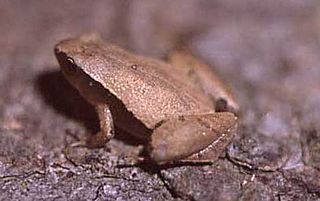
Microhyla heymonsi, also known as the dark-sided chorus frog or the Taiwan rice frog, is a species of narrow-mouthed frog found in northeastern India, southern China, Taiwan, and Southeast Asia south to the Malay Peninsula and Sumatra as well as the Great Nicobar Island. It was originally described from Taiwan.

Ranoidea platycephala, is a species of frog that is common in most Australian states and territories and is commonly referred to as the water-holding frog but has also been referred to as the eastern water-holding frog, and the common water holding frog. This species belongs to the Pelodryadinae subfamily of the Hylidae family but differs from most other members of this subfamily as it is a ground dweller and undertakes aestivation.

The southern marbled newt or pygmy marbled newt is a species of salamander in the family Salamandridae. It is found in Portugal and Spain. Its natural habitats are temperate forests, Mediterranean-type shrubby vegetation, rivers, intermittent rivers, freshwater marshes, intermittent freshwater marshes, arable land, pastureland, rural gardens, water storage areas, ponds, open excavations, irrigated land, canals and ditches. It is threatened by habitat loss.

The giant banjo frog, giant pobblebonk frog, giant bullfrog, or great bullfrog is a species of frog, endemic to Australia, in the family Limnodynastidae. Fry was the first to recognise the species of Giant Banjo Frog as a distinct subspecies of Banjo Frog, differing from the similar Southern or Eastern Banjo Frogs which occupied most of eastern Australia.
Asterophrys leucopus is a species of frog in the family Microhylidae. It is endemic to northwestern Papua New Guinea where it is known from three locations: Stolle Mountain in the Sandaun Province—its type locality, and Hunstein Mountains in the East Sepik Province and the Bewani Mountains in the West Sepik Province.
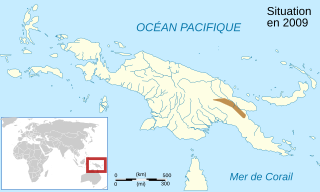
Cophixalus parkeri is a species of frog in the family Microhylidae. It is endemic to Papua New Guinea where it occurs in the central mountainous region between Chimbu and Morobe Provinces. The specific name parkeri presumably honours Hampton Wildman Parker, an English zoologist and herpetologist to whose perusal Arthur Loveridge sent the holotype. Common name Papua rainforest frog has been coined for it.

The copper-backed brood frog is a species of frog in the family Myobatrachidae. It is endemic to Australia. Its natural habitats are temperate forests, subtropical or tropical dry forests, rivers, intermittent rivers, freshwater marshes, and intermittent freshwater marshes from Mount Tamborine to Nerang.

Polypedates colletti is a species of frog in the family Rhacophoridae. It is found in the Malay Peninsula, southern Vietnam, Borneo, Sumatra, and islands of the South China Sea.
Papurana volkerjane is a species of true frogs, family Ranidae. It is endemic to New Guinea and is known from its type locality, the eastern slopes of the Wondiwoi Mountains, from the Fakfak Mountains, and from the Bewani and Torricelli Mountainss in the West Sepik Province, Papua New Guinea. Rainer Günther named the species after his son Volker and daughter-in-law Jane.



















